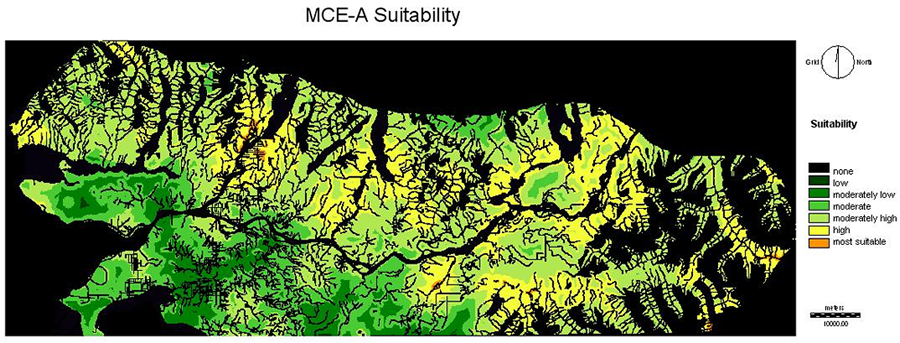
Home - Background - Data Acquisition - Methodology - Spatial Analysis - Problems - Discussion - References
Discussion____________________________________________________________________________________________________
The most accurate analysis is most likely MCE-A. This is because while sites within urban and agricultural areas are not ideal habitat locations for some reasons, the Pacific Water Shrew has been found within green spaces in these areas, and are therefore relatively suitable habitat locations. If Analysis C was used, then no suitable habitat locations would show up, since agricultural and urban areas are weighted so heavily, which is simply not the case since Pacific Water Shrew sitings and records have occurred (such as Mundy Park, as mentioned previously).
The most suitable locations of habitat for the Pacific Water Shrew occurs near water sources within the North Shore Mountains and in the Fraser River Valley to the southeast of the Fraser River. Suitable habitats occur in the northwest, as well as nearer to the southeast of the region. Within urban and agricultural areas the most suitable areas appear to be the area surrounding the University of British Columbia, the Burn's Bog area, West and North Vancouver, North Surrey just south of the Fraser River, as well as near the end of Burrard Inlet in Port Moody and Coquitlam. The image below shows these areas. This image was created using MCE-A and adding a vectorized water layer. This layer was created using the "rastervector" module, converting the image from raster to vector format. In order to help in conserving the Pacific Water Shrew, further steps should be taken to protect and take better care of these of suitable habitat areas.

If the an analysis of this type were to be conducted again, it would be useful to select a smaller area within the current range, such as the Greater Vancouver Regional District (GVRD), and change the factors and constraints used to locate suitable habitat locations within an urban and agricultural setting. It would be helpful to reduce the scope of the study so as to not include the entire range of the Pacific Water Shrew. This would produce a study more relevant to city planners, to locate which areas of the city should be under protection and not be allowed for development.
Jacquelyn Shrimer ~ jshrimer@sfu.ca ~ Geog 355